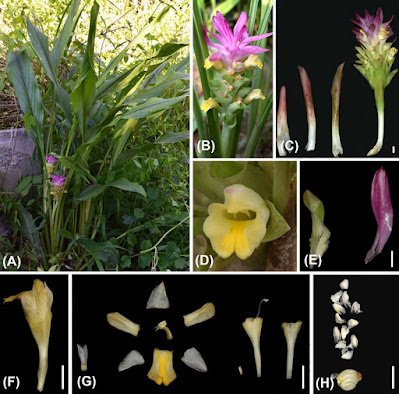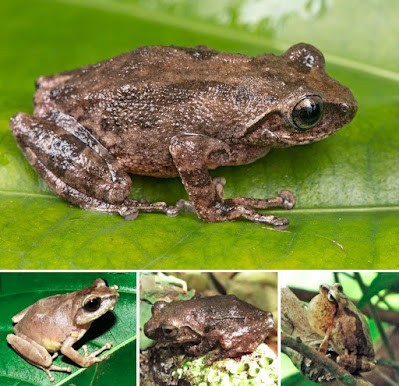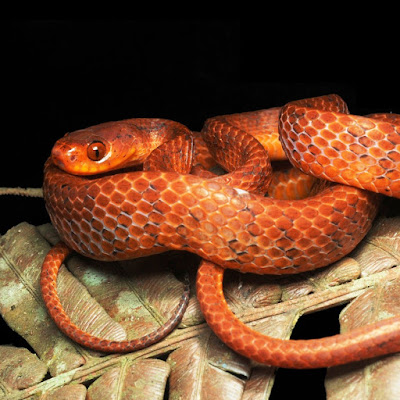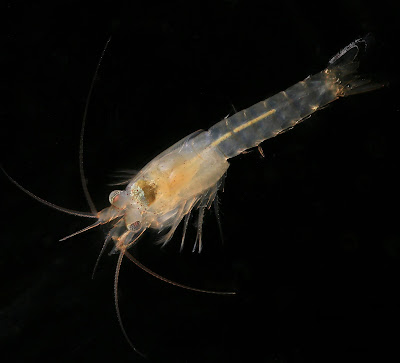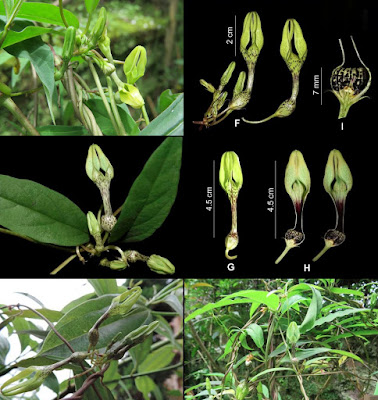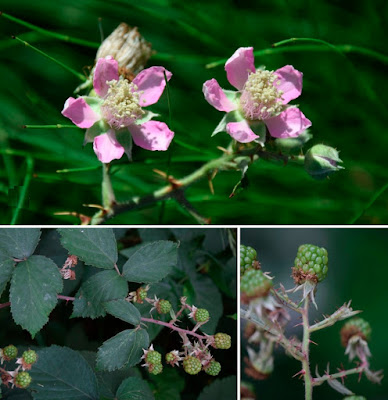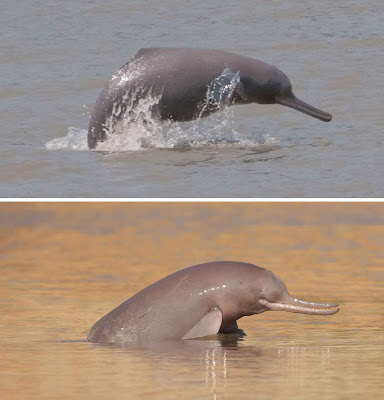[Most Recent Entries] [Calendar View]
Thursday, March 25th, 2021
| Time | Event | ||||||||
| 3:40a | [Botany • 2021] Curcuma ruiliensis (Zingiberaceae) • A New Species from Yunnan, China
Abstract A new species of Curcuma L. subg. Curcuma (Zingiberaceae) from China, C. ruiliensis N. H. Xia & Juan Chen, is described and illustrated. The chromosome number (2n = 84) is reported here. The new species is most similar to C. kwangsiensis S. G. Lee & C. F. Liang, but distinguished by pale yellow rhizomes, obovate tubers, longer ligule, lanceolate, obliquely spreading coma bracts, apex attenuate never obtuse, not reflexed, densely imbricated, lanceolate to ovate, obliquely spreading fertile bracts, apex narrowly acute never obtuse, not reflexed or slightly reflexed, larger flowers, longer calyx and fan‐shaped labellum. Keywords: Curcuma ruiliensis, new taxa, Yunnan Curcuma ruiliensis N. H. Xia & Juan Chen sp. nov. Etymology: The species epithet ‘ruiliensis' is derived from the locality where the first author collected this species, Ruili City, Yunnan, China. Chinese vernacular name and uses: 瑞丽莪术 [ruì lì é zhú]. No use has been reported. Juan Chen, Yu‐Shi Ye and Nian‐He Xia. 2021. Curcuma ruiliensis (Zingiberaceae), A New Species from Yunnan, China. Nordic Journal of Botany. DOI: 10.1111/njb.02910 | ||||||||
| 8:53a | [Herpetology • 2020] Raorchestes kollimalai • A New Cryptic Species of Bush Frog (Anura: Rhacophoridae: Raorchestes) from the Southern Eastern Ghats, India Abstract A new cryptic lineage of bush frogs of the genus Raorchestes from the understudied Eastern Ghats of India is described. Molecular phylogenetic reconstructions using mitochondrial 16S rRNA gene sequences suggest that the new species belongs to the Raorchestes charius clade, is sister to the allopatric R. charius of the Western Ghats and support the species-level distinctiveness of the lineage. The new species morphologically resembles R. charius from which it can be distinguished using the following characters: narrower head (HW/SVL 0.31 vs 0.34–0.36), wider inter upper eyelid (IUE/SVL 0.14–0.16 vs 0.11–0.13), greater maximum upper eyelid width (UEW/SVL 0.10–0.12 vs 0.06–0.09) and shorter thigh (TL/SVL 0.32–0.43 vs 0.44–0.51). Acoustic observations from the breeding males further corroborate the distinct specific status of the new species. The discovery of this new species of bush frog from an understudied landscape suggests that additional extensive surveys in the Eastern Ghats would yield several more amphibian lineages yet unknown to science. Key words: arboreal frog, cryptic species, Kollimalai Massif, Philautus, Rhachophoridae, systematics. Diagnosis. Raorchestes kollimalai sp. nov. is allocated to the genus Raorchestes based on the following combination of diagnostic characters: relatively small adult body size (SVL 15–45 mm), absence of vomerine teeth, presence of vocal sacs, which appear transparent/translucent while calling, and nocturnal habits. Dorsum light brown with dark brown spots. Canthus rostralis dark brown, a dark brown streak from posterior of the eye through the tympanic region terminating at the shoulder. Legs banded with dark brown. Pupil black with gold specks around it. A medium-sized bush frog (SVL 25.8–29.7 mm, n=3), characterized by wider than long head (HW/SVL 0.31, HL/SVL 0.26-0.30), short or subequal snout in comparison to the eye (SL/SVL 0.12–0.14 vs EL/SVL 0.14–0.15) and by relatively shorter hind limbs (ShL/SVL<0.50). Etymology. The specific epithet refers to the type locality, Kollimalai, as a noun in apposition and hence invariable. Suggested common name: Kollimalai bush frog. Gaurang G. Gowande, S.R. Ganesh and Zeeshan A. Mirza. 2020. A New Cryptic Species of Bush Frog (Amphibia: Anura: Raorchestes) from the Southern Eastern Ghats, India. TAPROBANICA: The Journal of Asian Biodiversity. 9(2); 164–173.DOI: 10.47605/tapro.v9i2.229 #herpetology #amphibians #Indianamphibians #frogs #biodiversity #easternghats #frogsofindia #scf #singinawa #sanctuaryasia #sanctuarynaturefounda #WCS #wildlife | ||||||||
| 10:54a | [Herpetology • 2020] Pareas geminatus • A New Species of the Pareas hamptoni Complex (Serpentes: Pareidae) from the Golden Triangle
Abstract An investigation of the taxonomic status of Pareas hamptoni (Hampton's Slug snake) based on morphological and molecular data revealed a new distinct species from the Golden Triangle region (comprising parts of southern China, and adjacent Laos and Thailand). The new species is shown to be a sister species to P. hamptoni but can be separated from the latter by having 3–5 dorsal scale rows at midbody slightly keeled (vs 5–9 scales strongly keeled); a lower number of ventrals, 170–188 (vs 185–195); and a lower number of subcaudals, 67–91 (vs 91–99). The new species is currently known from northwestern Thailand, northern Laos, and the southern part of Yunnan Province in China at elevations of 1,160–2,280 m a.s.l. We suggest that the new species to be considered of Least Concern (LC) in the IUCN's Red List categories. Problems of taxonomy and actual distribution of the P. hamptoni complex are briefly discussed; our results show P. hamptoni is now reliably known only from Myanmar and Vietnam, but its occurrence in Yunnan Province of China is likely. Key words: China, Indo-Burma, Laos, Pareas formosensis, Pareas mengziensis, Thailand
Pareas geminatus sp. nov. Diagnosis. Pareas geminatus sp. nov. differs from all congeners by the combination of the following morphological characters: a slender, yellow-brown, medium-sized snake (total length 566 mm); one or two anterior temporals; loreal not contacting the eye; prefrontal contacting the eye; one preocular; slightly enlarged median vertebral row; usually 7 (6–8) supralabials; 8 infralabial scales; 3–5 scale rows slightly keeled at midbody; 170–188 ventrals lacking lateral keels; 75–91 subcaudals, all divided; slightly billowing vertical dark bars on the trunk; two slight thin black postorbital stripes starting from lower and upper edges of postorbital scales; lower postorbital stripe reaching the anterior part of seventh supralabial, not continuing to the lower jaw and chin; the left and right upper postorbital stripes merge forming a black nuchal collar. Etymology. The specific epithet "geminatus" is a Latin adjective in nominative singular (masculine gender) derived from the Latin "geminus", for "twin", "double", and is given in reference to the similarity in morphology of the new species to its sister taxon, P. hamptoni, with which it was confused for a long time. We suggest the following common names: "Twin Slug snake" (English) and "Bó Zhòng Dùn Tóu Shé" (伯仲钝头蛇) in Chinese. งูกินทากลายขวั้น ງູກິນທາກລາຽຂວັ້ນ Distribution and natural history. The known distribution of Pareas geminatus sp. nov. is shown in Fig. 1. The new species is currently known from the Golden Triangle area, including the southernmost part of Yunnan Province, the northwestern part of Thailand, and the northern part of Laos. The occurrence of the new species in the extreme eastern corner of the Shan Plateau in Myanmar is anticipated. At the type locality in Jiangcheng County, Yunnan, China, Pareas geminatus inhabits tropical monsoon forests with clearly defined dry and wet seasons at elevations from 1,160 to 2,280 m asl. The new species was also recorded in highly modified secondary habitats with tea plantations (Fig. 5). The specimens of Pareas geminatus were observed at night after 2100 h while perching on vines or bushes ca. 1.0–1.5 m above the ground, waiting for prey. In China, the new species is threatened by intensifying human activity due to increasing deforestation for tea cultivation. Li Ding, Zening Chen, Chatmongkon Suwannapoom, Tan Van Nguyen, Nikolay A. Poyarkov and Gernot Vogel. 2021. A New Species of the Pareas hamptoni Complex (Squamata: Serpentes: Pareidae) from the Golden Triangle. TAPROBANICA: The Journal of Asian Biodiversity. 9(2); 174-193. DOI: 10.47605/tapro.v9i2.230 | ||||||||
| 1:22p | [Crustacea • 2021] Four New Species of Heteromysis (Olivemysis) (Crustacea: Mysida) from Public Aquaria in Hawaii, Florida, and Western to Central Europe
ABSTRACT Four new species of the subgenus Heteromysis (Olivemysis) were detected in material from (sub)-tropical aquaria in six public aquarium institutions around the globe. Modifications of pleopods by spines represent the strongest structural complex used for differentiation within this subgenus: male pleopods 1–4 modified in H. smithsoniana sp. nov., male pleopods 2–4 plus female pleopod 2 in H. hornimani sp. nov. and H. waikikensis sp. nov. Additional important diagnostic characters are provided by the antennulae, uropods, and telson. The male of H. sixi sp. nov. represents a very rare case within the genus Heteromysis by having only pleopod 2 modified by flagellate spines. The definition of the subgenus Olivemysis is modified in order to include H. sixi sp. nov. A summary of pleopod modifications in the genus Heteromysis and a key to the species of the subgenus Olivemysis are given. The here described new taxa more than double the number of Heteromysis species known from aquaria yet unknown in nature from three to seven. Keywords: first description, taxonomy, public aquarium institutions, modified pleopods, key to species Class Malacostraca Latreille, 1802 Order Mysida Boas, 1883 Family Mysidae Haworth, 1825 Subfamily Heteromysinae Norman, 1892 Tribe Heteromysini Norman, 1892 Genus Heteromysis S.I. Smith, 1873 Species inventory: A total of 39 species, including the new ones, is given in the key below. For 30 species see list in Price & Heard (2011). Nine species of this subgenus described after 2011 are H. cocoensis Price, Heard & Vargas, 2018; H. domusmaris Wittmann & Abed-Navandi, 2019; H. ekamako Wittmann & Chevaldonné, 2017; H. hornimani sp. nov.; H. ningaloo Daneliya, 2012; H. sabelliphila Wittmann & Wirtz, 2016; H. sixi sp. nov.; H. smithsoniana sp. nov. and H. waikikensis sp. nov. Heteromysis (Olivemysis) smithsoniana sp. nov. Etymology: The species name is a Latinized adjective with female ending, referring to the Smithsonian Marine Ecosystems Aquarium (Fort Pierce, Florida). Distribution: The species is so far known only from tanks in the ‘Smithsonian Marine Ecosystems Aquarium’, Fort Pierce, Florida. Origin most likely in coastal marine waters of the subtropical NW-Atlantic (Table 1) Heteromysis (Olivemysis) hornimani sp. nov. Etymology: The species name is a masculine noun in the genitive singular, referring to the Horniman Museum Aquarium, London. Distribution: The species is so far known only from tanks in the ‘Horniman Museum Aquarium London’ (UK), the ‘Oceanopolis Aquarium’ in Brest (France), the ‘Aquarium de Paris’ (France), and the ‘Zoo Wroclaw’ (Poland). The data from Paris suggest a Caribbean origin (Table 1: # 4). Heteromysis (Olivemysis) waikikensis sp. nov. Etymology: The species name is a feminine adjective formed by the addition of location suffix, related to the ‘Waikiki Aquarium’ (Honolulu, Hawaii) where the new species was detected. Distribution: The species is so far known only from an aquarium tank of the ‘Waikiki Aquarium’, Honolulu, Hawaii. Origin most likely in coastal marine waters of the Central Pacific (Table 1). Heteromysis (Olivemysis) sixi sp. nov. Etymology: The species name is a masculine noun in genitive singular, dedicated on the occasion of his retirement to Franz Six, citizen scientist and 55 year-long promoter of the ‘Haus des Meeres’, a public marine aquarium in Vienna. Distribution: The species is so far known only from a service tank of the ‘Waikiki Aquarium’, Honolulu, Hawaii. Origin most likely in coastal marine waters of the Central Pacific (Table 1). Karl J. Wittmann and Daniel Abed-Navandi. 2021. Four New Species of Heteromysis (Crustacea: Mysida) from Public Aquaria in Hawaii, Florida, and Western to Central Europe. European Journal of Taxonomy, 735(1), 133-175. DOI: 10.5852/ejt.2021.735.1247 | ||||||||
| 1:55p | [Botany • 2021] Ceropegia ansariana (Apocynaceae: Asclepiadoideae: Ceropegieae) • A New Species from Mizoram, Northeast India
Abstract Ceropegia ansariana (Apocynaceae: Asclepiadoideae: Ceropegieae: Chionopegia: Macranthae), a new species is described and illustrated from Blue mountain forests in Champhai district of Mizoram, Northeast India. The new species is superficially similar to Ceropegia khasiana Murug. et al., but it can be distinguished easily by its longer and fewer fascicled roots, 3–15-flowered cymes with 1–3 flowers open at a time, smaller greenish flowers 3.7–4.5 cm long, greenish with purplish maroon streaked and blotched on outer surface of corolla tube, greenish and shorter ovate-lanceolate corolla lobes, shorter inflated base with a few downwardly pointed hairs of different length at the throat and shorter and sparsely ciliate corona lobes. Detailed descriptions, photographic illustrations, phenology and a note on conservation status are provided here. Keyword: Asia, Blue Mountain forests, Ceropegia khasiana, Ceropegieae-Stapeliinae, Champhai district, Flora of India Ceropegia ansariana Murug. & A.A. Mao sp. nov. Type: INDIA, Mizoarm, Champhai District, Blue mountain forest areas (22°_'_''N 93°_'_''E ), 1250 m elevation, 14 July 2018, Naim Ansari & M. Murugesan 137396 (holotype ASSAM; isotype MH!). Diagnosis: The new species is morphologically closely allied to Ceropegia khasiana but it differs in having longer and fewer fascicled roots, 3–15-flowered cymes with 1–3 flowers open at a time, smaller greenish flowers 3.7–4.5 cm long, greenish with purplish maroon streaked and blotched on outer surface of corolla tube, greenish and shorter ovate-lanceolate corolla lobes with short ciliate, shorter inflated base with a few downwardly pointed trichomes of different length at the throat and shorter and sparsely ciliate corona lobes (Table 1). Distribution: So far known only from Blue Mountain forested areas, Champhai district of Mizoram, India. Also introduced in Botanical Garden of Botanical Survey of India, Shillong, Meghalaya, India for ex situ conservation purposes. Ecology: Occasional along forest margins at an altitudinal range between 1000 and 1250 m above sea level. A total of nine mature individuals were located in the type locality. Etymology: The new species is named in honour of Dr. M.Y. Ansari for his significant contribution on Indian Ceropegia. Maruthakkutti Murugesan and Ashiho A. Mao. 2021. Ceropegia ansariana (Apocynaceae: Ceropegieae), A New Species from Mizoram, Northeast India. Taiwania. 66(2);121-125. DOI: 10.6165/tai.2021.66.121 | ||||||||
| 2:13p | [Botany • 2021] Rubus noricus (Rosaceae) • Hidden on Both Sides of the Alps: A New Species of Bramble from Austria and Germany
Rubus ser. Rhamnifolii includes apomictic polyploid species, which occur in north-western and central Europe, with rare outposts to eastern central Europe. A regionally distributed tetraploid species of the series occurring north and south of the Eastern Alps in Austria and Germany, Rubus noricus is described here. The new species is morphologically compared with similar taxa of the series, moreover, comprehensive iconography, data on distribution and ecology are presented. Keywords: apomixis, biogeography, ecology, postglacial spread, Rubus ser. Rhamnifolii, taxonomy, Eudicots Rubus noricus Hohla, Pagitz & Király, sp. nov. Etymology:— The epithet “noricus” derives from the former Roman province “Noricum” that approximately covered the eastern Alps and its foregrounds, which overlap well with the species’ distribution area. Ecology:— Rubus noricus was found in the colline and submontane altitudinal belts from 320 to 600 m above sea level. The species generally grows on slightly acidic (e.g. silicate-rich gravel or granite) to base-rich (e.g. limestone) substrates, on semi-dry to mesic soils, both in natural forest communities (most often in associations of the Fagetalia order), and their derivates (e.g. planted coniferous stands, partly mixed with native deciduous tree species). It prefers half-shady fringes or somewhat opened forest stands, in turn, it avoids exposed sunny sites. Michael Hohla, Konrad Pagitz and Gergely Király. 2021. Hidden on Both Sides of the Alps: Rubus noricus, A New Species of Bramble (Rosaceae) from Austria and Germany. Phytotaxa. 489(1); 1–9. DOI: 10.11646/phytotaxa.489.1.1 | ||||||||
| 2:57p | [Mammalogy • 2020] Platanista gangetica & P. minor • Taxonomic Revision of the South Asian River Dolphins (Platanista): Indus and Ganges River Dolphins are Separate Species
Abstract South Asian river dolphins (Platanista gangetica) are among the most endangered of the world's cetaceans. The two subspecies in the family Platanistidae, Indus, and Ganges river dolphins (P. g. minor and P. g. gangetica), are both threatened by dams and barrages, declining river flows, fisheries bycatch, and pollution. We examine differences in external and skull morphology between dolphins in each river system to clarify their taxonomic status. Skulls from each river system could easily be differentiated using diagnostic differences in the shape of the frontal bones behind the nasals. This feature was present in all individuals irrespective of size, age, and sex. Ganges river dolphins are sexually dimorphic with females larger than males, but there was no evidence of dimorphism in the small sample of Indus river dolphins. There were no mitochondrial DNA haplotypes shared between the two river systems, and five fixed differences suggested a long‐term (approximately 0.55 million years) absence of gene flow. Diagnosable differences in morphological and genetic characteristics indicate long‐term reproductive as well as geographic isolation of Indus and Ganges river dolphins. We conclude that Indus and Ganges river dolphins should each be recognized as distinct species, and elevate the Indus subspecies, Platanista gangetica minor, to species level, Platanista minor Owen, 1853. Formal redescriptions are provided for both species. Keywords: endangered species, river dolphins, speciation, taxonomy
Order Cetartiodactyla Montgelard, Catzefils and Douzery, 1997 Cetacea Brisson, 1762 Odontoceti Flower, 1867 Superfamily Platanistoidea Gray, 1863 Family Platanistidae Gray, 1846 Genus Platanista Wagler, 1830 Platanista gangetica (Lebeck, 1801) Diagnosis: The skulls can be differentiated from those of P. minor by the presence of a projection at the frontal suture above the nasals and behind the maxillary crests (Figure 4). While there is some overlap in tooth counts between Indus and Ganges river dolphins, all skulls with less than 30 teeth in the upper tooth rows are Ganges river dolphins. The Ganges river dolphin has three unique mtDNA haplotypes (HAP4‐6, see Braulik, Barnett, et al., 2015, GenBank accession numbers KJ629311‐13) with five fixed differences separating it from the Indus river dolphin. Etymology: This species is known as the Ganges river dolphin after the river system from which it was described. We recommend the English common name Ganges river dolphin for this species. It is known by many different local names within its range including, Susu (popular), Soons/Soans/Soos (Hindi and dialects), Shushuk (Bengali), Hiho/Hihu (Assamese), Bhagirath, Socho (Hindi/Maithili: eastern Bihar), Shus or Suongsu (Nepali), Shishumar (probable medieval name in Sanskrit), Pani Suar (name during the Mughal period).
Platanista minor Owen, 1853 Diagnosis: Indus river dolphin skulls can be differentiated from those of the Ganges river dolphin by the absence of a projection at the frontal suture above the nasals and behind the maxillary crests on the skull (Figure 4). While there is some overlap in tooth counts between Indus and Ganges river dolphins, all skulls with more than 33 teeth in the upper tooth rows are Indus river dolphins. The Indus river dolphin has three unique mtDNA haplotypes (HAP1‐3, see Braulik, Barnett, et al., 2015, GenBank accession numbers KJ629309, KJ629310 & AJ554058) with five fixed differences separating it from the Ganges river dolphin. Etymology: We recommend the English common name Indus river dolphin for the species. It is known as bhulan in the local languages of Pakistan, and northwest India, where it occurs. CONCLUSIONS: Indus and Ganges river dolphins are the sole remaining relicts of the entire Platanistoidea cetacean superfamily and thus from the perspective of evolutionary distinctiveness their conservation is of key importance. The recognition of two species of Platanista detailed above requires a re‐evaluation of their conservation status. Both are currently listed as Endangered on the IUCN Red List and are already among the most endangered of all cetaceans. There is now an urgent need to elevate these species to a higher level of conservation concern and priority. This is especially true for the Indus river dolphin, which has declined drastically throughout most of its range due to its massive altered and degraded habitat (Braulik, Noureen et al., 2015). The Ganges river dolphin, although presently more numerous, is under great threat due to proposed and ongoing large infrastructure projects that have the potential to destroy large swaths of the most important habitat for the species (Kelkar, 2017). Gill T. Braulik , Frederick I. Archer, Uzma Khan, Mohammad Imran, Ravindra K. Sinha, Thomas A. Jefferson, Carl Donovan and Jeff A. Graves. 2021. Taxonomic Revision of the South Asian River Dolphins (Platanista): Indus and Ganges River Dolphins are Separate Species. Marine Mammal Science. DOI: 10.1111/mms.12801 |
| << Previous Day |
2021/03/25 [Calendar] |
Next Day >> |
